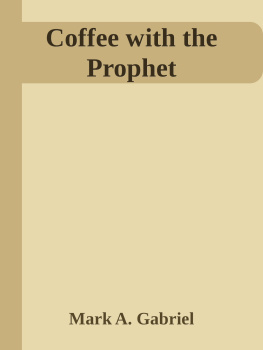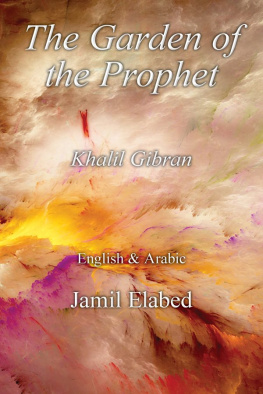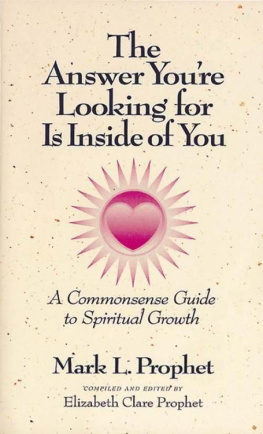Mark A. Gabriel - Coffee with the Prophet
Here you can read online Mark A. Gabriel - Coffee with the Prophet full text of the book (entire story) in english for free. Download pdf and epub, get meaning, cover and reviews about this ebook. year: 2008, publisher: Gabriel Publishing, genre: Religion. Description of the work, (preface) as well as reviews are available. Best literature library LitArk.com created for fans of good reading and offers a wide selection of genres:
Romance novel
Science fiction
Adventure
Detective
Science
History
Home and family
Prose
Art
Politics
Computer
Non-fiction
Religion
Business
Children
Humor
Choose a favorite category and find really read worthwhile books. Enjoy immersion in the world of imagination, feel the emotions of the characters or learn something new for yourself, make an fascinating discovery.
- Book:Coffee with the Prophet
- Author:
- Publisher:Gabriel Publishing
- Genre:
- Year:2008
- Rating:4 / 5
- Favourites:Add to favourites
- Your mark:
- 80
- 1
- 2
- 3
- 4
- 5
Coffee with the Prophet: summary, description and annotation
We offer to read an annotation, description, summary or preface (depends on what the author of the book "Coffee with the Prophet" wrote himself). If you haven't found the necessary information about the book — write in the comments, we will try to find it.
Coffee with the Prophet — read online for free the complete book (whole text) full work
Below is the text of the book, divided by pages. System saving the place of the last page read, allows you to conveniently read the book "Coffee with the Prophet" online for free, without having to search again every time where you left off. Put a bookmark, and you can go to the page where you finished reading at any time.
Font size:
Interval:
Bookmark:
by Mark A. Gabriel
Former Lecturer of Islamic History at Al-Azhar University
Coffee with the
Prophet
A 21st Century Encounter with the Prophet of Islam
Coffee with the Prophet
by Mark A. Gabriel, PhD
Published by Gabriel Publishing
P. O. Box 181974
Casselberry, FL 32718
USA
www.gabrielpublishing.org
www.coffeewiththeprophet.com
This book or parts thereof may not be reproduced in any form, stored in a retrieval system, or transmitted in any form by any meanselectronic, mechanical, photocopy, recording, or otherwise, without prior written permission of the publisher, except as provided by United States of America copyright law.
Unless otherwise noted, all quotations from the Quran are from The Quran Translation , 7th edition, translated by Abdullah Yusef Ali (Elmhurst, NY: Tahrike Tarsile Quran, Inc., 2001).
Quotations from the Quran marked Muhsin Khan are from The Noble Quran , translated by Muhammad Taqi-ud-Din al-Hilali and Muhammad Muhsin Khan (Medina, Saudi Arabia: King Fahd, 1988).
Quotations from the Quran marked Shakir are from the electronically scanned versions of M. H. Shakirs English translation of the Holy Quran (Elmhurst, NY: Tahrike Tarsile Quran, Inc.).
Copyright 2008 by Mark A. Gabriel, PhD
All rights reserved
ISBN-13: 978-0-61520-728-5
Library of Congress Control Number: 2008938056
First Edition
08 09 10 11 12 9 8 7 6 5 4 3 2 1
Printed in the United States of America
Dedicated to Naguib Mahfouz
(1912 2006)
Winner of the 1988 Nobel Prize in Literature
Dr. Mahfouz, I miss your joyful, intellectual meetings at the Rish Coffee Shop in the center of Cairo. The words you said one night are still ringing in my ears. You encouraged us:
Write! Dont fear the religious taboos, which are the reason for our nations backward living. Our nation has used the past to create a giant prison, and we are the prisoners locked in it. Be like birds; turn your pens into wings and fly with our people into the sky of religious freedom.
Dr. Mahfouz, I cannot have coffee with you anymore, but I think that Coffee with the Prophet would make you proud. I am answering your challenge to turn my pen into a wing, and I am flying into the sky of religious freedom. I am praying not just for my people but for the whole world to fly with me.
Your student in literature,
Mark A. Gabriel
Contents
Introduction
1 I Am a Hafiz
2 The Holy Ground
3 Family Secret
4 Stoning Satan
5 An Unexpected Companion
6 Better than Camels
7 The Mosque of the Prophet
8 A Mysterious Phone Call
9 Suicide Shame
10 Enemies of Islam
11 The Afghani Man
12 The Amrad Man
13 A Disturbing Dream
14 The Faithful and the Unfaithful
15 The Womans Place
16 Daring Questions
17 The Apostates
18 Trapped
19 Family Crisis
20 Explanations
21 A Dark Mosque
22 The Angel of Death Speaks
23 Pray for Mercy
24 Judgment Day
Epilogue: What Happened to Mustafa?
Notes
Bibliography
Glossary
Index of Quranic References 210
Authors Academic Credentials
Introduction
Coffee with the Prophet is a fictional story, but youre going to learn more about fact than fantasy in this book.
In this book you will meet an enigmatic character named Sheikh Ahmed, who befriends Mustafa, a young lecturer at Al-Azhar University in Cairo. Sheikh Ahmed seems to be a simple tribesman, but Mustafa discovers that he has a much bigger agenda. I will not tell you at this point whether Sheikh Ahmed is really Muhammad, the Prophet of Islam, or not. You will discover that for yourself as you read the book.
However, when you hear Sheikh Ahmed speak, you hear the attitudes and opinions of Muhammad. And when you see Sheikh Ahmed on the cover of the book, you see a realistic picture of what Muhammad looked like. Through Coffee with the Prophet , you are going to experience what it would be like to walk and talk with Muhammad in the twenty-first century, just as he walked and talked with his companions in the seventh century.
The character of Sheikh Ahmed is based as closely as possible on how the Quran and Islamic history described Muhammad. If you want to see these sources, read the Notes section in the back of the book. It is organized by chapter and will give you the original sources from Islamic history, often including the direct quote and the website where you can read the entire passage in English for yourself.
Just as Sheikh Ahmed is based on Muhammad, the character of Mustafa is based on my life twenty years ago when I was a lecturer at Al-Azhar. For the safety and privacy of the people from my past, all character names are fictional, including names of family, friends, and professors at Al-Azhar. The only non-fictional names in the book are public figures (like Naguib Mahfouz) or figures from Islamic history. In fact, in this story I have also changed the location of my family home and the number of siblings in order to keep their identities secret.
Youve heard the saying, Truth is stranger than fiction. If you would like to know more about the personal experiences in my life that contributed to Mustafas story, see the Notes section. The Notes will also tell you about news events that are included in the story, such as the woman who was arrested at Starbucks or the Muslim convert who was protected by the Pope.
Some terms that I use may be unfamiliar to you, so I have also included a glossary with words such as surah (chapter), hadith, hajj, burqa , and so on. When I quote from the Quran I usually use the English translation of Yusuf Ali. If I quote from a different translation, such as Muhsin Khan or Shakir, I will put the name of the translator next to the reference.
Finally, I want to address some issues that may cause people to unfairly criticize or condemn this book. As one who lived in Muslim society for thirty-four years, I realize that the nature of this book may cause some controversy. I am going to explain these issues now before they become overly exaggerated.
The Image on the Book Cover
First, lets consider the image on the cover. Some people may say, Are you deliberately trying to provoke Muslims by using this picture? Dont you know that Muslims consider it blasphemy to make a drawing of Muhammad?
First of all, there is not a specific verse in the Quran or hadith (stories from the life of Muhammad) that condemns making an image of Muhammad. The Quran, which has the highest authority in Islamic law, emphasizes that images are wrong when they are used as idols, but the Quran does not condemn images in general.
A ban on drawings in general comes from Muhammads words in the hadith. Muhammad said, All painters who make pictures would be in the fire of HellIf you have to do it at all, then paint the pictures of trees and lifeless things (See Notes for the complete quote.) In other words, Muhammad prohibited making images of people and animals. Sunni Muslims accept this hadith, but Shia Muslims reject it because it originated with Aisha, one of Muhammads wives, and Shia reject all hadith from her. Therefore, Shia history includes some drawings of Muhammad and his companions. In addition, at different times in history, Sunni Muslims ignored this hadith and also made drawings of people, including Muhammad, especially during the Ottoman Empire. The bottom line is that drawing an image of Muhammad is not at all universally condemned in the Muslim world.
I am not trying to provoke Muslims by using this image. I simply want to show what Islamic history says about the appearance of Muhammad. Most people dont realize that the hadith describe Muhammads height, hair, clothes, shoes, face, hands, feet, and jewelry. (For more information, see the Notes section). My purpose is to present factual information.
Font size:
Interval:
Bookmark:
Similar books «Coffee with the Prophet»
Look at similar books to Coffee with the Prophet. We have selected literature similar in name and meaning in the hope of providing readers with more options to find new, interesting, not yet read works.
Discussion, reviews of the book Coffee with the Prophet and just readers' own opinions. Leave your comments, write what you think about the work, its meaning or the main characters. Specify what exactly you liked and what you didn't like, and why you think so.













